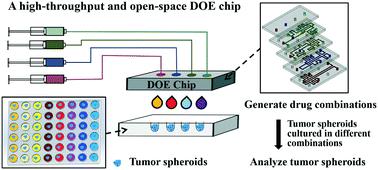Our official English website, www.x-mol.net, welcomes your
feedback! (Note: you will need to create a separate account there.)
A high-throughput, open-space and reusable microfluidic chip for combinational drug screening on tumor spheroids
Lab on a Chip ( IF 6.1 ) Pub Date : 2021-08-24 , DOI: 10.1039/d1lc00525a Lijun Li 1, 2 , Yan Chen 2 , Huirong Wang 2 , Geng An 3 , Hongkai Wu 1, 4 , Wei Huang 2
Lab on a Chip ( IF 6.1 ) Pub Date : 2021-08-24 , DOI: 10.1039/d1lc00525a Lijun Li 1, 2 , Yan Chen 2 , Huirong Wang 2 , Geng An 3 , Hongkai Wu 1, 4 , Wei Huang 2
Affiliation

|
Screening drug combinations using tumor spheroids can play a vital role in the development of disease treatment and personalized medicine. However, current studies focus on drug gradients or combinations of two drugs in most cases, and it is difficult to find complex therapeutic combinations involving more drugs. The use of design-of-experiment (DOE) microfluidics is a potential strategy to study this area systematically. Here we develop a high-throughput, open-space multilayered PMMA microfluidic chip for combinational drug screening on tumor spheroids. This microchip is straightforward to fabricate, compatible with standard spheroid cultures, and friendly for end-users. The device consists of an inlet layer and multiple dispersing layers. In the inlet layer, different samples can be loaded into the chip simultaneously. The sample solutions flow into the dispersing layers to generate various combinations based on the specific DOE principle. We demonstrated that the chip performance is in quantitative agreement with the design, using water and doxycycline combinations as models. As a proof-of-concept study, we constructed a HeLa reporter cell line to quantify the autophagy of tumor spheroids and used the chip to identify critical factors relating to the growth of the spheroids. Specifically, we used L-glutamine, D-glucose, FBS, and cisplatin as the factors and studied the autophagy, growth curves, and spheroid sizes in response to different combinations of the four factors. We found that D-glucose can inhibit the effects of cisplatin on tumor spheroids, and cisplatin caused severe autophagy in 3D tumor spheroids compared to 2D monoculture cells. Our method has the potential to allow more drug combinations to be examined, and it can be extended to DOE approaches with seven or more inputs.
中文翻译:

一种用于肿瘤球体联合药物筛选的高通量、开放空间和可重复使用的微流控芯片
使用肿瘤球体筛选药物组合可以在疾病治疗和个性化医疗的发展中发挥重要作用。然而,目前的研究大多集中在药物梯度或两种药物的组合上,很难找到涉及更多药物的复杂治疗组合。使用实验设计 (DOE) 微流体是系统研究该领域的潜在策略。在这里,我们开发了一种高通量、开放空间的多层 PMMA 微流控芯片,用于对肿瘤球体进行组合药物筛选。这种微芯片易于制造,与标准球体培养物兼容,对最终用户友好。该装置由一个入口层和多个分散层组成。在入口层,不同的样品可以同时加载到芯片中。样品溶液流入分散层,根据特定的 DOE 原理产生各种组合。我们使用水和强力霉素组合作为模型,证明了芯片性能与设计在定量上一致。作为概念验证研究,我们构建了 HeLa 报告细胞系来量化肿瘤球体的自噬,并使用该芯片来识别与球体生长相关的关键因素。具体来说,我们使用了 我们构建了一个 HeLa 报告细胞系来量化肿瘤球体的自噬,并使用芯片来识别与球体生长相关的关键因素。具体来说,我们使用了 我们构建了一个 HeLa 报告细胞系来量化肿瘤球体的自噬,并使用芯片来识别与球体生长相关的关键因素。具体来说,我们使用了L-谷氨酰胺、D-葡萄糖、FBS和顺铂作为因子,研究了四种因子不同组合下的自噬、生长曲线和球体大小。我们发现D-葡萄糖可以抑制顺铂对肿瘤球体的影响,与 2D 单培养细胞相比,顺铂在 3D 肿瘤球体中引起严重的自噬。我们的方法有可能允许检查更多的药物组合,并且它可以扩展到具有七个或更多输入的 DOE 方法。
更新日期:2021-08-24
中文翻译:

一种用于肿瘤球体联合药物筛选的高通量、开放空间和可重复使用的微流控芯片
使用肿瘤球体筛选药物组合可以在疾病治疗和个性化医疗的发展中发挥重要作用。然而,目前的研究大多集中在药物梯度或两种药物的组合上,很难找到涉及更多药物的复杂治疗组合。使用实验设计 (DOE) 微流体是系统研究该领域的潜在策略。在这里,我们开发了一种高通量、开放空间的多层 PMMA 微流控芯片,用于对肿瘤球体进行组合药物筛选。这种微芯片易于制造,与标准球体培养物兼容,对最终用户友好。该装置由一个入口层和多个分散层组成。在入口层,不同的样品可以同时加载到芯片中。样品溶液流入分散层,根据特定的 DOE 原理产生各种组合。我们使用水和强力霉素组合作为模型,证明了芯片性能与设计在定量上一致。作为概念验证研究,我们构建了 HeLa 报告细胞系来量化肿瘤球体的自噬,并使用该芯片来识别与球体生长相关的关键因素。具体来说,我们使用了 我们构建了一个 HeLa 报告细胞系来量化肿瘤球体的自噬,并使用芯片来识别与球体生长相关的关键因素。具体来说,我们使用了 我们构建了一个 HeLa 报告细胞系来量化肿瘤球体的自噬,并使用芯片来识别与球体生长相关的关键因素。具体来说,我们使用了L-谷氨酰胺、D-葡萄糖、FBS和顺铂作为因子,研究了四种因子不同组合下的自噬、生长曲线和球体大小。我们发现D-葡萄糖可以抑制顺铂对肿瘤球体的影响,与 2D 单培养细胞相比,顺铂在 3D 肿瘤球体中引起严重的自噬。我们的方法有可能允许检查更多的药物组合,并且它可以扩展到具有七个或更多输入的 DOE 方法。











































 京公网安备 11010802027423号
京公网安备 11010802027423号